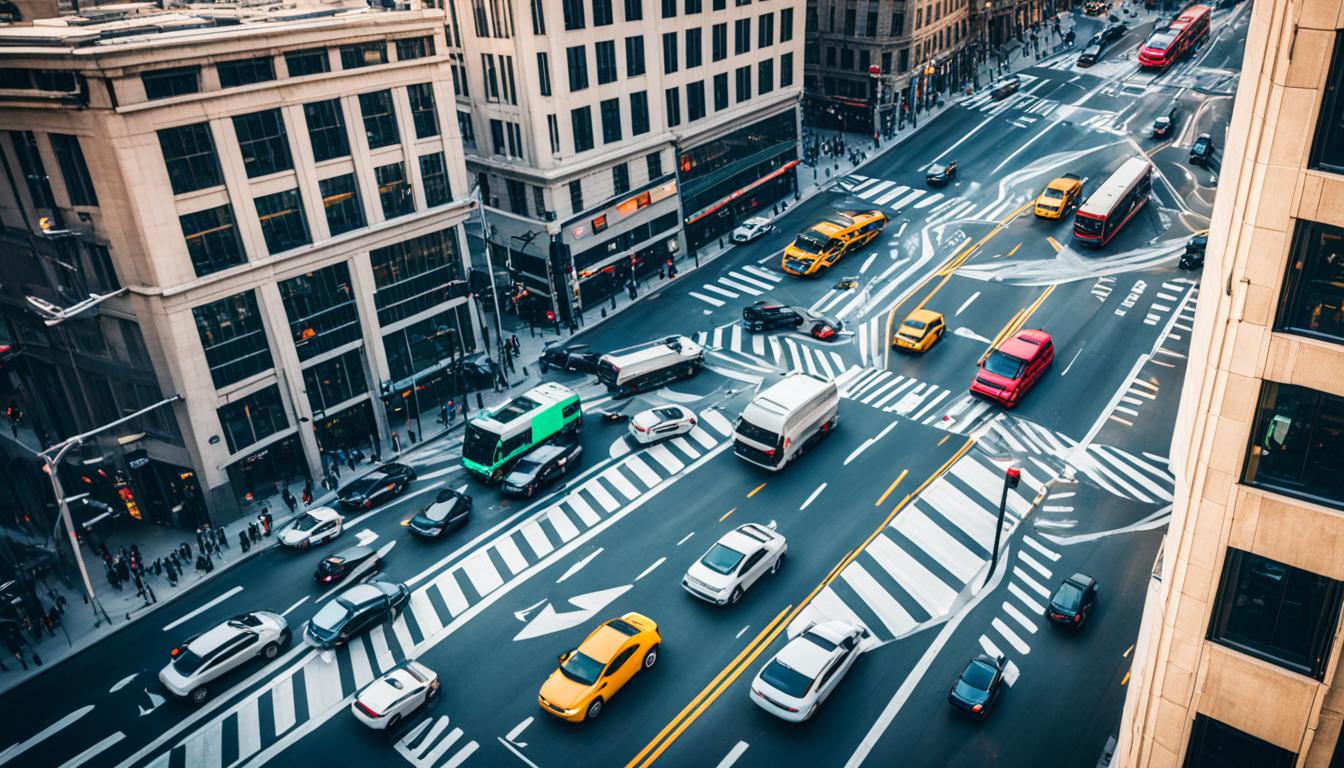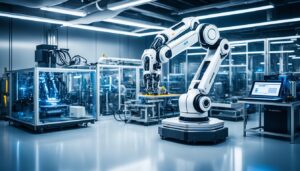
Air pollution is a big problem worldwide. It harms our health, causing breathing issues, heart diseases, and sometimes, early death. But, technology brings us hope for cleaner air.
AI is leading the fight against air pollution. It uses technology to check air quality as it changes, giving quick updates to everyone. This helps people make smart choices every day, like where to go and what to do.
AI also warns us when air quality is getting worse. It predicts what might happen and lets people know. This way, we can stay safe and reduce the harm of bad air.
One main cause of air pollution is too many cars on the road. AI helps by making traffic flow better. This means cars spend less time running, which cuts down on pollution. Cleaner air benefits us all.
Key Takeaways:
- AI technology enables real-time monitoring of air quality, providing immediate analysis and updates.
- Early warning systems powered by AI help forecast air quality deterioration and issue alerts.
- AI-driven traffic optimization systems reduce congestion, lower emissions, and contribute to sustainable transportation.
- AI assists in identifying pollution sources, optimizing control measures, and reducing emissions in industrial settings.
- Mobile apps and wearable devices powered by AI provide real-time air quality information to the general public.
AI in Real-Time Monitoring and Early Warning Systems
Artificial intelligence (AI) is changing the game in air quality monitoring. It helps cities fight pollution better and make urban areas healthier. By using advanced sensors and IoT devices, AI provides instant, accurate air quality data.
This AI technology helps government agencies and the public know about air quality. It measures air pollutants and gives real-time data. This helps everyone make better decisions for outdoor activities.
Authorities can use this data to improve air quality. They can find and address pollution sources. For example, sensors can identify industrial or vehicle emissions. This lets authorities take quick actions to reduce pollution.

“The ability to detect pollution sources and take targeted interventions is paramount in the fight against air pollution. AI technology provides the tools we need to monitor air quality in real-time and implement timely measures that safeguard public health.” – Dr. Jane Mitchell, Environmental Scientist
AI is also key in creating early warning systems for bad air quality. By looking at past data, AI can predict air quality trends. It can send warnings when air quality is expected to get worse. This lets people and authorities take steps to stay safe.
With AI’s help, cities can tackle air pollution by taking specific actions, raising awareness, and encouraging green practices. AI technology lets us aim for cleaner air and healthier lives for everyone.
AI in Traffic Optimization, Pollution Control, and Emission Reduction
AI systems play a key role in easing traffic jams, a big source of city pollution. They look at live traffic data to improve how traffic flows. This means changing traffic lights dynamically, giving route tips, and predicting traffic jams. By cutting down on the time cars spend idling, AI not only saves fuel but also cuts emissions. This helps make the air in our cities cleaner.
AI also helps spot where pollution comes from and finds the best way to fight it. It uses machine learning to examine satellite and sensor data, spotting high-pollution spots. This info helps focus on specific ways to lessen pollution. For example, setting up air cleaners and planning green projects. Thanks to this, air quality gets better, leading to healthier, more lasting cities.
Besides dealing with pollution from cars, AI also helps lower industrial emissions. It uses predictive maintenance to tell when machines need fixing or replacing. This keeps operations smooth and emissions low. It ensures that energy use is efficient and helps with eco-friendly transportation methods.
AI’s role in improving traffic, fighting pollution, and cutting emissions is huge. It offers a big chance to make our cities greener. With AI, we’re moving towards cleaner air and a better future for the next generations.
FAQ
How does AI contribute to air quality monitoring?
Can AI help in developing early warning systems for air quality deterioration?
How does AI optimize traffic flow to reduce air pollution?
How does AI help identify pollution sources and optimize control measures?
Can AI reduce emissions in industrial settings?
How can individuals access real-time air quality information?
How can policymakers benefit from AI in air quality improvement?
Source Links
- https://www.cleanairfund.org/news-item/ai-wearables-innovative-tech/
- https://www.linkedin.com/pulse/breathing-easier-ai-powered-air-quality-management-rama-chintakunta
- https://dornsife-wrigley.usc.edu/news/what-artificial-intelligence-can-teach-us-about-the-air-we-breathe-and-what-we-have-to-teach-it/






